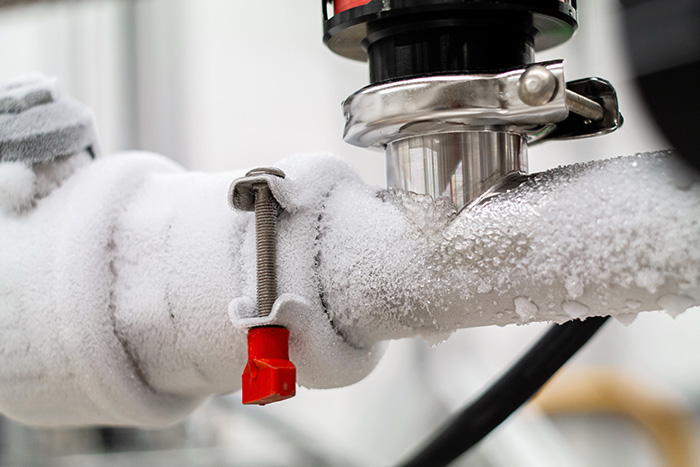Avoiding Your Pipes from Freezing: Top Tips
Avoiding Your Pipes from Freezing: Top Tips
Blog Article
We've found this post pertaining to 6 Ways to Prevent Frozen Pipes directly below on the web and believe it made sense to write about it with you here.

Winter can ruin your plumbing, particularly by freezing pipelines. Below's exactly how to avoid it from happening and what to do if it does.
Introduction
As temperature levels decrease, the danger of frozen pipelines boosts, possibly resulting in costly fixings and water damage. Understanding just how to avoid frozen pipelines is essential for homeowners in cool environments.
Understanding Icy Pipes
What triggers pipelines to freeze?
Pipelines freeze when exposed to temperature levels below 32 ° F (0 ° C) for extended durations. As water inside the pipes freezes, it increases, taxing the pipe walls and possibly triggering them to break.
Dangers and damages
Icy pipelines can lead to water supply interruptions, residential property damage, and pricey repair work. Ruptured pipes can flooding homes and create comprehensive structural damages.
Indicators of Frozen Pipeline
Recognizing icy pipes early can avoid them from breaking.
How to determine icy pipelines
Search for reduced water circulation from taps, uncommon odors or noises from pipes, and visible frost on subjected pipelines.
Avoidance Tips
Shielding susceptible pipes
Wrap pipes in insulation sleeves or use heat tape to protect them from freezing temperature levels. Concentrate on pipes in unheated or exterior locations of the home.
Home heating methods
Keep indoor spaces properly warmed, particularly areas with pipes. Open closet doors to allow warm air to distribute around pipes under sinks.
Securing Outdoor Pipes
Garden pipes and outdoor faucets
Separate and drain yard hose pipes prior to winter. Set up frost-proof faucets or cover outside faucets with insulated caps.
What to Do If Your Pipelines Freeze
Immediate activities to take
If you believe icy pipes, keep taps open to ease pressure as the ice thaws. Utilize a hairdryer or towels taken in hot water to thaw pipes gradually.
Long-Term Solutions
Structural modifications
Take into consideration rerouting pipes away from exterior wall surfaces or unheated locations. Include extra insulation to attics, basements, and crawl spaces.
Updating insulation
Buy high-quality insulation for pipes, attics, and walls. Appropriate insulation helps maintain consistent temperatures and decreases the danger of frozen pipes.
Conclusion
Stopping frozen pipes requires proactive measures and quick responses. By understanding the reasons, indicators, and safety nets, house owners can safeguard their plumbing throughout winter.
6 Proven Ways to Prevent Frozen Pipes and Protect Your Home
Disconnect and Drain Garden Hoses
Before winter arrives, start by disconnecting your garden hoses and draining any remaining water. Close the shut-off valves that supply outdoor hose bibs and leave the outdoor faucet open to allow any residual water to drain. For extra protection, consider using faucet covers throughout the colder months. It’s also important to drain water from any sprinkler supply lines following the manufacturer’s directions.
Insulate Exposed Pipes
Insulating your pipes is an effective way to prevent freezing. Pipe insulation is readily available at home improvement stores and is relatively inexpensive. Pay close attention to pipes in unheated areas such as the attic, basement, crawl spaces, or garage. Apply foam insulation generously to create a buffer against the cold. You can also wrap your pipes in heat tape or thermostat-controlled heat cables for added warmth.
Seal Air Leaks
Inspect your home for any cracks or openings that could let in cold air. Seal any holes around the piping in interior or exterior walls, as well as the sill plates where your home rests on its foundation. Additionally, make sure to keep your garage door closed unless you’re entering or exiting. Leaving it open creates a significant air leak that can lead to frozen pipes.
Allow Warm Air Circulation
During cold snaps, it’s essential to allow warm air to circulate evenly throughout your home. Leave interior doors ajar to promote better airflow. Open kitchen and bathroom cabinets to help distribute heat consistently around the rooms. If you have small children or pets, be sure to remove any household chemicals or potentially harmful cleaners from open cabinets for safety.
Let Faucets Drip
A small trickle of water can make a big difference in preventing ice formation inside your pipes. When temperatures drop significantly, start a drip of water from all faucets served by exposed pipes. This continuous flow helps prevent the water from freezing. Additionally, running a few faucets slightly can relieve pressure inside the pipes, reducing the chances of a rupture if the water inside does freeze.
https://choateshvac.com/6-proven-ways-to-prevent-frozen-pipes-and-protect-your-home/

I hope you enjoyed reading our post about Preventing and dealing with frozen pipes. Thanks a lot for spending some time to browse our article. Enjoyed reading our blog? Please share it. Let somebody else find it. I value your readership.
Click Here Report this page